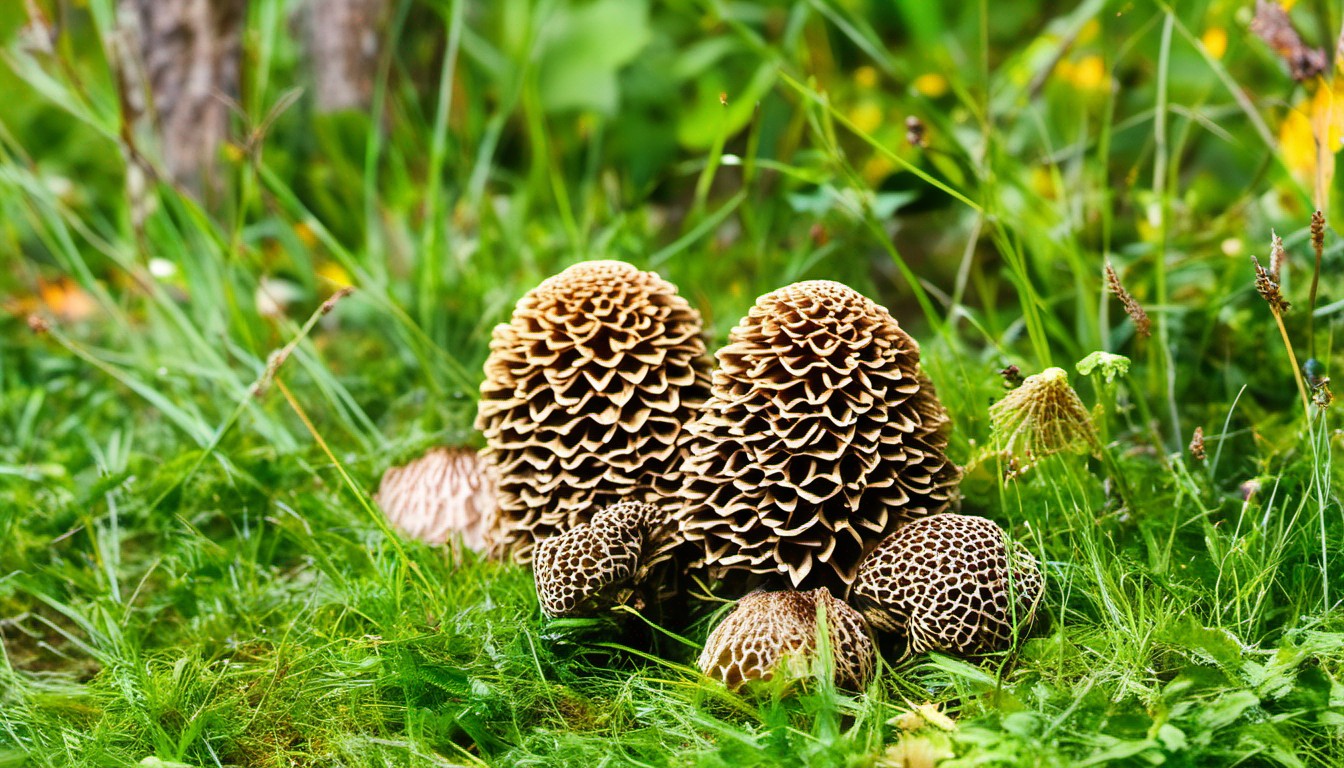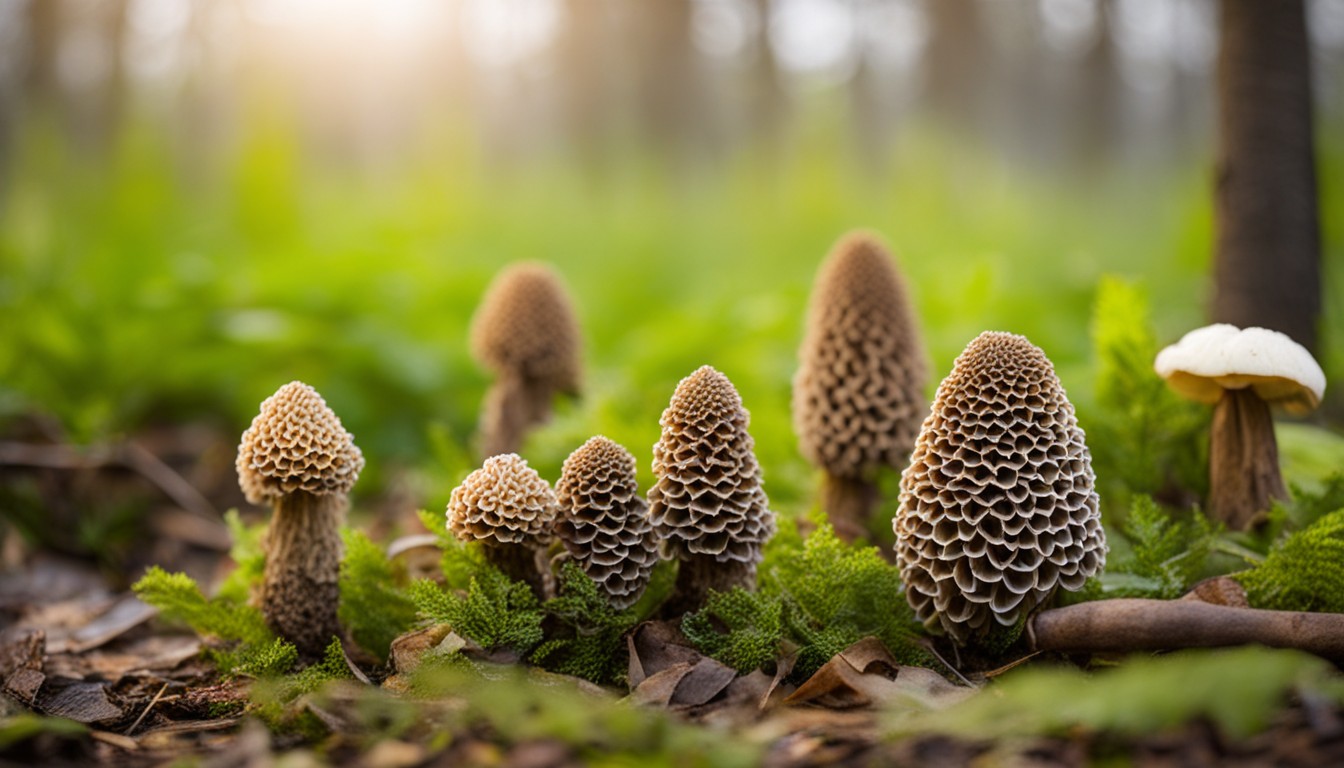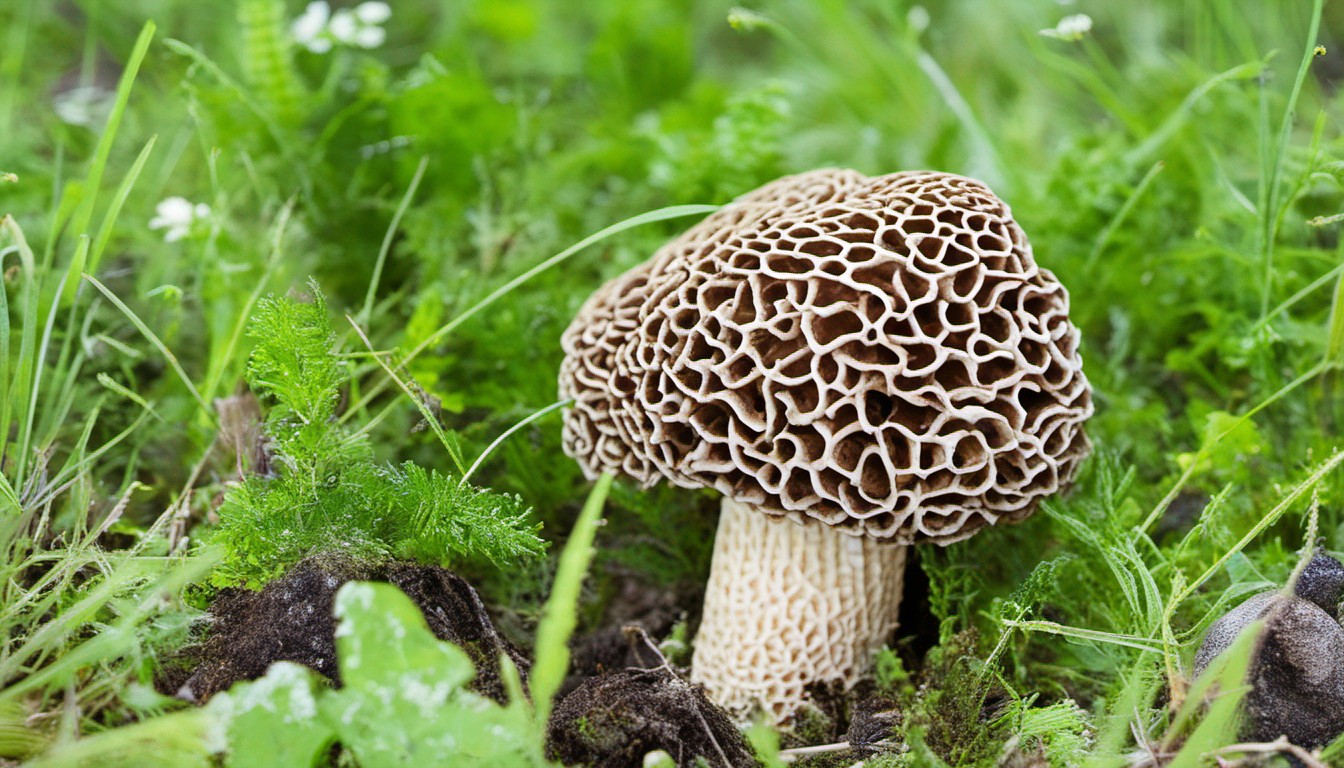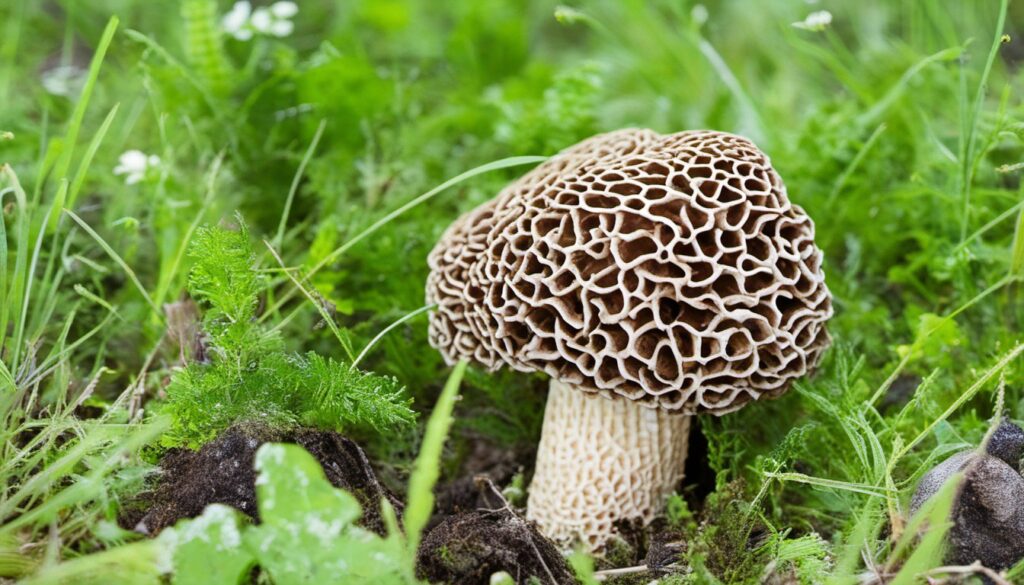Morel mushrooms are highly sought after by foragers in North Carolina, thanks to their unique flavor and appearance. If you’re new to mushroom foraging or looking to improve your success rate, here are some tips to help you find abundant morel mushrooms in the lush forests of NC. From understanding their preferred habitats to knowing the best time to search, these insights will enhance your foraging skills and increase your chances of a successful trip. Let’s dive into the fascinating world of morel mushrooms and uncover the secrets to successful foraging in NC!
When and Where to Find Morel Mushrooms
Morel mushroom foraging in North Carolina reaches its peak during the spring, particularly from March to May. The seasonality is driven by soil temperature and moisture, which promotes the growth of these distinctive fungi.
The growth of Morel mushrooms thrives in the specific conditions of spring and in the aftermath of forest fires or floods, especially in mixed hardwood forests of North Carolina.
Morels are often found in abundance in areas that have experienced recent forest fires or flooding. Mixed hardwood forests, particularly those featuring ash, elm, and apple trees, are promising locations for morel hunting in North Carolina.
Understanding the Morel Mushroom Season in NC
In North Carolina, morel mushrooms typically begin their growth cycle in the spring, between late March and early May. This period, particularly after a rainfall, casts the most opportune stage for the successful collection of these seasonal delicacies.
Daily temperature oscillations play a critical role in driving morel growth, with optimal conditions ranging between 50 and 70 degrees Fahrenheit. Accompanied by sufficient moisture, these precise atmospheric conditions pave the way for generous yields of morel mushrooms in North Carolina.
Exploring Ideal Habitats for Morel Mushrooms
Morel mushrooms in North Carolina favor patches of loamy or sandy soil, found often in the state’s deciduous forests. These fungi thrive in areas rich in organic matter and nutrient content. Ideal habitats also boast plenty of decaying leaves and woody debris, all key elements for thriving morel mushroom colonies.
Pay attention to areas that have experienced a recent forest fire. Often, morel mushrooms increase drastically in abundance following such burnings. The fire eliminates competition and enriches the soil with nutrients, thereby creating a perfect environment for morel mushrooms to flourish.
Morel mushrooms have a unique affinity for burnt areas because the extreme heat compels the fungi to fruit profusely. A year or two after a forest fire, you might find the forest floor covered in these tasty morsels. However, the distinctive pattern is ephemeral, lasting only a couple of years before reverting to normal.
Consider exploring hardwood forests, specifically near elm, ash, and apple trees. Morel mushrooms form symbiotic relationships with these trees, harnessing their nutrients for growth. Don’t ignore sycamores and poplars either, another favored habitat for these elusive mushrooms.
Also worth noting, Morels in North Carolina often flourish in disturbed ground such as path edges, roadsides, and clearings. While not as dense as areas impacted by forest fires, these locations may still provide a substantial haul for keen-eyed foragers.
Identifying Morel Mushrooms
True morels, distinguishable by their honeycomb-like exterior and hollow interior, are valued for their distinct flavor. Protruding cap covered in pits and ridges, usually elongated, and containing no stems or cottony structures is the correct identification of morel mushrooms.
Conversely, false morels also known as beefsteaks, exhibit a wrinkled, brain-like, or lobed appearance, solid stems, and aren’t hollow. A primer must be well-informed and confident about these distinctions to avoid potentially harmful false morels frequently mistaken for true morels.
Examining the Physical Characteristics of Morel Mushrooms
Distinctive from most fungi, morel mushrooms boast a unique honeycomb-like structure, with pits and ridges blanketing their conical caps. This hallmark texture, combined with their pale brown to dark black color, sets them apart anatomically.
A noteworthy characteristic of an authentic morel is the cap-to-stem attachment. True morels have caps that are fully attached to the stem, forming a continuous hollow interior from base to apex.
Forest enthusiasts often battle distinguishing between true morels and their toxic lookalikes, the false morels. The latter possesses wrinkled, rather than pitted, caps and the inside is typically filled with cotton-like fibers or tissue.
To guarantee the safe consumption of morels, it’s essential to examine every gathered specimen. Cutting the mushroom longitudinally from the cap through the stem to ensure a hollow interior is a reliable way of confirming a true morel.
Despite the variety of colors morels may sport, they all display the same honeycomb structure. Therefore, learning to identify these physical characteristics is an indispensable foraging skill for all mushroom enthusiasts in NC.
Distinguishing Morel Mushrooms from Toxic Look-alikes
Recognizing true Morels from their poisonous counterparts means closely examining their unique pattern of pits and ridges. True Morels, unlike toxic variants, showcase a honeycomb surface structure, nestled between deep pits, and elevated ridges.
A false Morel possesses a different physical appearance. Key distinguishing traits include irregular and lobed caps, rather than honeycombed, and often a brain-like texture. A keen eye for these differences is essential to avoid toxic encounters.
Upon finding a suspected Morel, dissecting it vertically can provide essential clues. Genuine Morels will exhibit a hollow interior, a feature absent in the toxic varieties. This method, combined with external analysis, ensures safer foraging.
Preparation Tips for Foraging

Knowing the life cycle of morel mushrooms assists in boosting the harvest. Learn their growth patterns, optimum conditions, and the impact weather changes have on their emergence. This enriches your understanding and enhances the success of your foraging adventure.
Preparing for morel foraging requires not only knowledge but also essentials like a mesh bag for ventilation, comfortable walking shoes for uneven terrains, and a detailed map. Your preparedness significantly increases the chances of a profitable hunt.
Assembling the Right Foraging Gear
Choosing the right tools is crucial for a successful morel foraging mission. Essential items recommended for your kit include a sturdy basket for collection, a small brush for dirt removal, a pocket knife for harvesting, and a field guide for mushroom identification.
Safety also plays a pivotal role in morel foraging. Key gear such as a compass or GPS for navigation, a first-aid kit for unexpected injuries, suitable clothing for woodland terrains, and a cell phone for emergencies should be part of your foraging equipment to augment success and safety.
Understanding Foraging Laws and Restrictions in NC
Foraging morels in North Carolina isn’t a free-for-all; you need to understand legal boundaries to remain lawfully compliant. The laws vary based on whether you’re in public or private lands. On public lands, there may be certain areas off-limits or require permits.
Permits issued by the U.S. Forest Service or local agencies, if required, confer rights to forage, albeit with certain restrictions. These can define how much can be collected, the type of resources, and the time period. Understanding these restrictions is crucial.
Private lands require a different approach, where explicit permission from the landowner is necessary. In NC, foraging without consent on someone else’s property is considered trespassing and could lead to consequences. Always secure proper permissions before foraging on private properties.
Beyond legalities, respect for private property and the environment is key. Foraging manners encompass leaving minimal traces of your activities, not encroaching on growing crops, and replenishing back the land to safeguard biodiversity. Remember, sustainable foraging ensures a healthy harvest next season- for everyone.
Safety Precautions for Foraging Morel Mushrooms
Foraging for Morel mushrooms necessitates utmost safety. Avoiding dangerous flora and fauna, observing meticulous hygiene practices, and taking into account certain health considerations are all integral elements of a safe Morel mushroom harvest.
- Equip yourself with sturdy gloves and long-sleeved shirts to evade skin-to-skin contact with hazardous plants.
- Identify local dangerous animals and have a basic knowledge about self-defense measures.
- Carry a small first-aid kit to treat minor injuries.
- After collection, wash Morel mushrooms thoroughly to get rid of potential bacteria, parasites, or insect larvae.
- Always cook Morel mushrooms before consumption; they may cause some problems if eaten raw.
- Consult with local experts or communities about potential health risks associated with Morel mushroom foraging.
Effective Techniques for Morel Mushroom Foraging

Adopting a systematic foraging approach, including the use of detailed maps and frequent visits to potential locations, is integral for efficient Morel Mushroom hunting in NC. Regular scouting provides better understanding of mushroom growth patterns enhancing chances of yield.
Patience and diligence form the foundation of successful Morel Mushroom foraging in NC. Morels, known for their elusive nature, require foragers to maintain a keen eye, carefully examining underneath fallen leaves, near deciduous trees, and moist areas to spot them.
Scouting Potential Morel Mushroom Locations
To become a successful morel forager in NC, it’s crucial to develop a keen-eyed approach. Observing the environment subtly can unveil potential Morel hotspots. Learn to recognize cues like decaying wood, moist areas, and certain tree types that morels favor.
Pre-foraging scouting sets the groundwork for a productive collecting day. Develop a habit of making preliminary visits just before the Morel season starts in NC. This strategy helps identify prime hunting grounds in advance.
Studying landscape details is essential. Morels typically thrive in dappled sunlight and mossy areas. Bald spots in the forest floor and decaying organic matter are telltale signs of morel patches.
Observation is key, the layout of land plays a significant role. Note areas where water gathers after rainfall and natural forest paths. These become strategic landmarks during your actual foraging.
Pay attention to the trees. Morels are known to grow near dead or dying trees like elms, ash, and tulip poplar in NC. Spotting these trees could point you towards a morel goldmine.
Examining Underneath Fallen Leaves and Branches
Delving beneath the layer of fallen leaves and decaying branches often reveals the hidden treasure of Morel Mushrooms. These areas provide the humid and shaded conditions, which are ideally suited for Morel colonization.
A meticulous examination is essential to unearth hidden Morel Mushrooms beneath the surface. Intently inspecting the undersides of leaf piles and fallen branches can reveal an elusive cluster of Morels nested quietly beneath.
However, care should be taken while exploring such areas. Disturbing the ecosystem too excessively may jeopardize the current and future growth of Morel Mushrooms, highlighting the importance of gentle and mindful foraging.
Searching Near Deciduous Trees and Moist Areas
Optimal habitats for Morel mushrooms are conglomerations of deciduous trees and damp environments. The unique blend of nutrients found in these areas promotes mushroom growth and reproduction. Species like ash, elm, and poplar trees put out organic matter that Morels can absorb, helping them flourish.
Morels have a symbiotic relationship with deciduous trees. They attach to the roots, exchanging water and nutrients in perfect harmony. This relationship not only subsidizes their growth but also benefits the trees, nurturing a thriving ecosystem.
Understanding the intricacy of this relationship is crucial to successful foraging in NC. Identifying areas with a high concentration of deciduous trees near streams or damp soils can lead you to a bountiful Morel collection. Look beneath fallen leaves or near decayed logs to discover these hidden gems.
Tips for Spotting Morel Mushrooms in Forested Areas
The art of noticing Morel Mushrooms in forest undergrowth involves honing your observational skills. Focus on ground-level visual cues and learn to decipher the patterns formed by the mushroom’s unique honeycombed cap amidst the forest floor’s cluttered panorama.
In the labyrinth of NC’s Forested areas, success in Morel Mushroom hunting heavily relies on the understanding and utilization of ecosystem clues. Observing dead or dying trees, particularly elms, sycamores, and ashes can often lead to promising mushroom spots.
Take note of shifts in terrain and vegetation, as these could indicate transitions between ecological zones favoring Morel growth. Increased moisture, shade, and leaf litter accumulation suggests a microhabitat that Morels favor.
Morels also thrive amongst disturbed soils. Look for areas with recent flooding or logging activities. Combining these eco-locator tactics with a keen eye will significantly boost your chances of locating these elusive delicacies.
Harvesting and Handling Morel Mushrooms
To minimize damage during Morel mushroom harvest in North Carolina, use a sharp knife to cut them at the base, allowing the rest of the fungus’s body to remain intact and reproduce. Avoid pulling them out, which can disturb the mycelium underground, hindering future yields.
After gathering Morel mushrooms in North Carolina, preserve their quality through immediate cleaning; use a soft brush to remove dirt without damaging the fragile flesh. Store them in a breathable bag within a cool place; refrigeration works best. Proper maintenance helps retain texture and taste.
Gently Harvesting Morel Mushrooms to Avoid Damage
Properly harvesting Morel mushrooms in North Carolina requires gentleness to maintain the fungi’s integrity. Cutting Morels at their base, rather than yanking, prevents damaging the root system, ensuring their future growth.
Preserving the ecosystem plays a pivotal role in harvesting. Excessively invasive techniques not only harm the current crop but influence future crops. It’s prudent to consider the mushroom’s entire lifecycle while harvesting.
Sustainable harvesting lays the foundation for regular, abundant yields in following seasons. Emphasizing careful harvest, symbiotic relationship with hosts, and ecosystem balance helps secure both the mushroom’s existence and your foraging success.
Properly Cleaning and Storing Morel Mushrooms

Precise cleaning of Morel mushrooms maximizes their shelf-life. Brush away debris gently, avoid soaking, and never use soap, as it can taint the morel’s natural flavor. Opt for cool, dry storage to prevent fungal and bacterial growth.
Storing morels in the refrigerator? Wrap lightly in damp paper towels, then into an unsealed bag. This approach maintains moisture without encouraging rot, keeping morels fresh for a week.
To maintain their distinctive taste and texture longer, consider drying morels. Dehydrated morels can be rehydrated, offering a consistency close to freshly harvested ones, even after a year.
For freezing, blanch morels briefly before transferring to a freezer-safe bag. This method ensures preservation of flavor and texture while extending the life of your foraging findings.
FAQ
What are morel mushrooms?
Morel mushrooms are a type of edible fungus known for their distinctive honeycomb-like appearance and earthy flavor. They are highly coveted by foragers for their unique taste and culinary versatility.
Where can I find morel mushrooms in North Carolina?
Morel mushrooms can be found in the forests of North Carolina, particularly in areas with rich soil, such as riverbanks, wooded slopes, and under certain tree species like ash, elm, and tulip poplar. Exploring different types of forests and microhabitats can increase your chances of finding these elusive mushrooms.
When is the best time to forage for morel mushrooms in NC?
The best time to forage for morel mushrooms in North Carolina is typically in the spring, when the temperatures start to warm up and the soil moisture is just right. It is important to monitor the weather conditions and check for recent rainfall, as these factors can influence the emergence of morel mushrooms.
How do I identify morel mushrooms?
Morel mushrooms have a unique appearance, with their cone-shaped cap and wrinkled, sponge-like texture. They can vary in color from light tan to dark brown. It is crucial to familiarize yourself with their distinguishing features and consult reliable field guides or experienced foragers to ensure accurate identification.
Are morel mushrooms safe to eat?
Yes, morel mushrooms are safe to eat when properly identified and cooked. However, it is essential to be cautious when foraging and only consume mushrooms that you can positively identify. If you are uncertain about the identification, it is best to seek guidance from an expert mycologist to avoid any potential risks.
Can I cultivate morel mushrooms in my garden?
While it is challenging to cultivate morel mushrooms, some experienced gardeners have had success by creating specific growing conditions and using a technique called “spore slurry.” It involves introducing morel spores or mycelium to suitable soil and providing the optimal environmental conditions for their growth. However, the success rate may vary, and cultivating morels is often considered more feasible on a larger scale.
What is the best way to cook morel mushrooms?
Morel mushrooms can be enjoyed in a variety of ways, such as sautéing them with butter and garlic, incorporating them into pasta dishes, or adding them to a creamy mushroom soup. The key is to preserve their unique flavor and delicate texture. Some chefs recommend minimal cooking to maintain their distinct taste, while others prefer a more robust preparation method to bring out their earthy notes.
Are there any poisonous mushrooms that resemble morel mushrooms?
Yes, there are some poisonous mushrooms that may resemble morels, such as the false morels. False morels can be toxic and should be avoided. It is crucial to educate yourself on proper identification techniques, including examining the cap, stem, and spore characteristics, to distinguish true morels from potential look-alikes. When in doubt, always err on the side of caution and consult an expert.
Can I sell morel mushrooms that I forage?
Selling foraged mushrooms is subject to regulations and permits. It is advisable to check with local authorities and follow any legal requirements before selling morel mushrooms. Some states have specific regulations regarding the sale of wild mushrooms, while others may restrict commercial foraging altogether. It is important to understand and comply with the rules and regulations in your area.
Is it legal to forage for morel mushrooms in North Carolina?
Foraging for mushrooms in North Carolina is generally allowed for personal consumption. However, it is important to respect private property rights and obtain any necessary permits or permissions when foraging on public land. It is advisable to familiarize yourself with the specific rules and regulations governing mushroom foraging in your area, as they may vary depending on the location and land ownership.
Please note that mushroom identification and foraging should be done with a high level of caution and expertise. It is always recommended to learn from experienced foragers, attend workshops or foray groups, and continue expanding your knowledge to ensure a safe and enjoyable foraging experience.
Conclusion
To sum up, successful morel mushroom foraging in NC involves a deep understanding of the mushroom’s seasonal availability and preferred habitat, the ability to correctly identify Morels and differentiate them from toxic look-alikes, and knowledge of proper foraging prep, techniques, and mushroom handling procedures.
- Keep track of areas where you found morels for future reference.
- Stay updated on local laws and guidelines related to foraging.
- Always ensure safe handling and storage of harvested mushrooms.
- Seek guidance from experienced foragers or mushroom clubs in NC.
- Consider participating in local mushroom foraging events.

